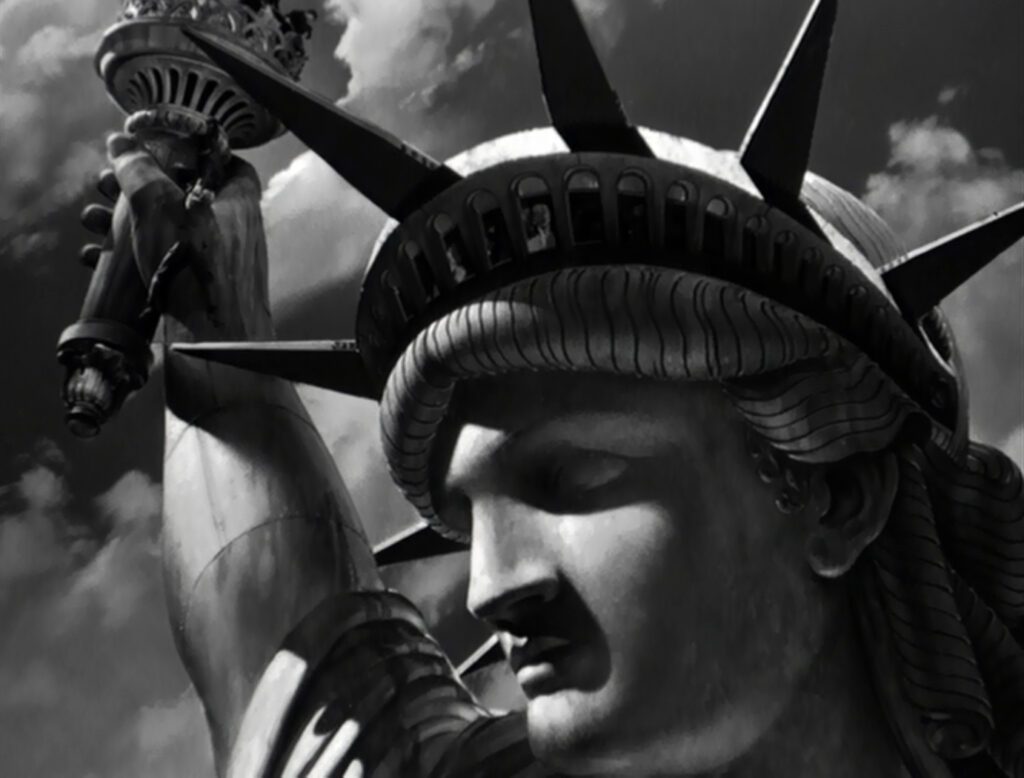
Saboteur
1942, directed by Alfred Hitchcock
Three minutes into Saboteur a shot of the burning aircraft factory drives home the horror of the initial act of sabotage. A ghastly cloud of black smoke spreads across a corrugated metal wall from right to left. Normally on a studio production like this the art director would be charged with the particulars of such a shot, but Saboteur‘s art director Jack Otterson reported that Alfred Hitchcock knew exactly what he wanted in it. That was not so unusual; Hitchcock storyboarded his movies carefully, and he had a precise idea of how they should look, even before shooting. However in this case Hitchcock had a special reason to take control. Not only does the shot illustrate the destruction of a factory in California supplying the U.S. military – the smoke coming from the right also makes it an abstract map of the evil threatening to spread over the United States from east to west.
Saboteur was released less than five months after the Pearl Harbor attack, but Hitchcock was long in the habit of warning audiences against European fascism, and the movie is more concerned with the European threat than the Japanese threat. The dark smoke billowing sickeningly over the sheet metal signifies the spectre of fascism approaching from the east. Although the Nazi influence was across the Atlantic, at the moment there was greater reason to fear a fifth column aiding fascism from within American society than an actual trans-oceanic invasion. Still, any influence would come from the power centers on the east coast, symbolically tainted by proximity to Europe.
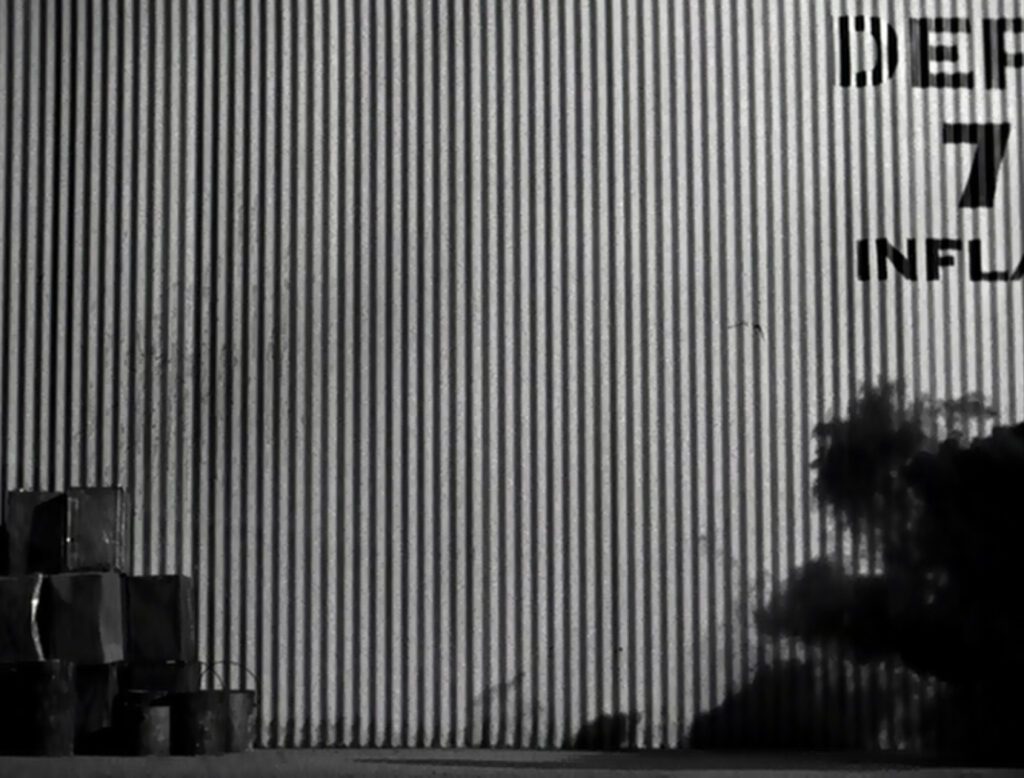
Hitchcock’s own background informed the particular shape and concerns of Saboteur. He was born in London to a humble background; his father was an East End greengrocer, and the family was Roman Catholic. He had worked briefly in Germany in the mid-1920s and had spent much of the 1930s making spy thrillers that warned the British of an impending tyrannical threat from the continent. In spite of his commercial success he was still an outsider in the English film establishment, a lower-class filmmaker of undistinguished education who did not make respectable literary films. Thus when Hollywood producer David O. Selznick offered him a contract to work in America he seized the chance and relocated to California.
Life in the United States was a welcome change for Hitchcock. He had opportunities to make bigger productions with wider distribution, and he would be respected. However three of his first four American films were set in England or Europe, and the one set in America was a light screwball comedy made as a favor to actress Carole Lombard. Throughout his career Hitchcock usually directed material given to him by other writers, but he wrote the original outline for Saboteur himself. It was his first chance to express his feelings for his newly adopted country, and the movie is a loving ode to the United States.
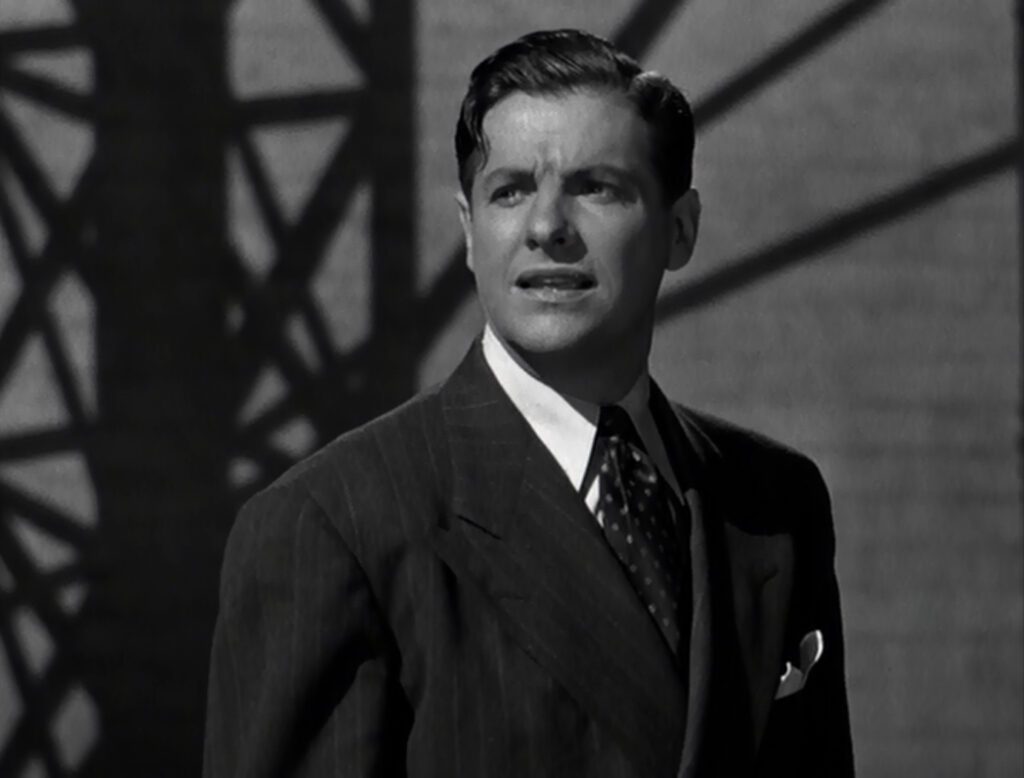
Protagonist Barry Kane is an all-American young man, an aircraft factory worker whose name in a corny American way evokes the title of Citizen Kane, implying that he’s an average American citizen. Wrongly accused of sabotage, he spends the movie steering clear of the law while also trying to clear himself by finding the actual perpetrator, a young man named Frank Fry who had handed him a fire extinguisher filled with gasoline. Remembering the address on an envelope Fry had dropped, Kane hitches a ride with a jovial truck driver, another all-American guy with typical American humor, who helps Kane escape the police because like a regular American he roots for the underdog and relishes a bit of action.
Barry Kane’s adventure takes him across the country, and all along it is filled with tropes of American culture. At Tobin’s ranch Kane establishes a useful rapport with a toddler by playing ball with her – ball games being an essentially American pastime. When he escapes from the ranch in a horse chase, the movie momentarily turns into the most American of genres, a Western. From there he finds a self-reliant old blind man named Philip Martin living in a log cabin. Mr. Martin’s niece Patricia is a billboard model. When Barry and Patricia hitch a ride in a circus wagon, the circus freaks vote to decide whether or not to turn Kane in to the police. And in case a ball game, the Wild West, a log cabin, a billboard, and an election aren’t enough Americana, the movie takes Barry Kane to the Hoover Dam, the Brooklyn Navy Yard, Rockefeller Center, and finally to the ultimate symbol of the United States – the Statue of Liberty.
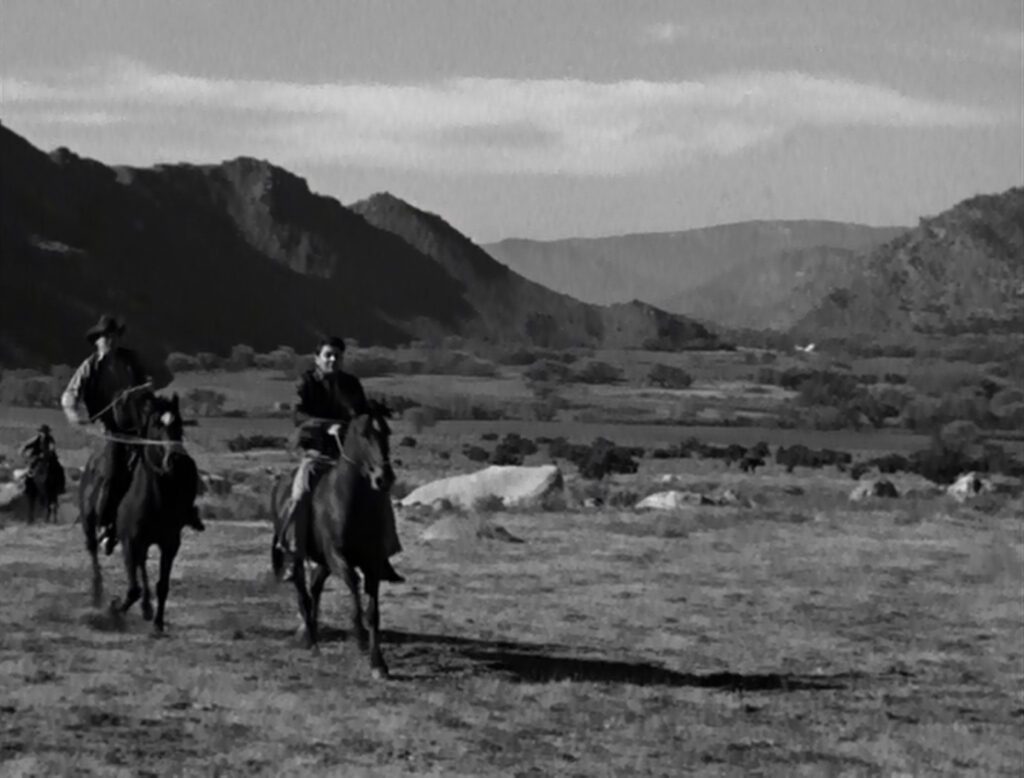
In contrast to quintessentially American characters like Kane, the truck driver, and Philip and Patricia Martin, the villains project European qualities through their appearance, manner, and Mid-Atlantic accents. Mr. Tobin, the power-hungry tycoon and fascist agent who organizes acts of sabotage, comes across as a genteel and debonair gentleman. Mrs. Sutton, the wealthy New York socialite who raises funds for Tobin’s activities, resembles a British aristocrat, and unlike Barry Kane, Frank Fry hardly passes for a regular American guy.
The odd thing about Saboteur is that it reverses the normal direction of American narrative by moving from west to east. Europeans had settled the country in the opposite direction, and westward movement was still the ideal in the American mind. A prevailing notion of the American Dream was to move west and claim your place in the world. Saboteur does not try to overturn this trope, but its surprising reversal underscores the gravity of America’s present circumstances. In effect, the movie is saying that American civilization needs to look backward from its comfortable home in the west to confront the corruption spreading from Europe.
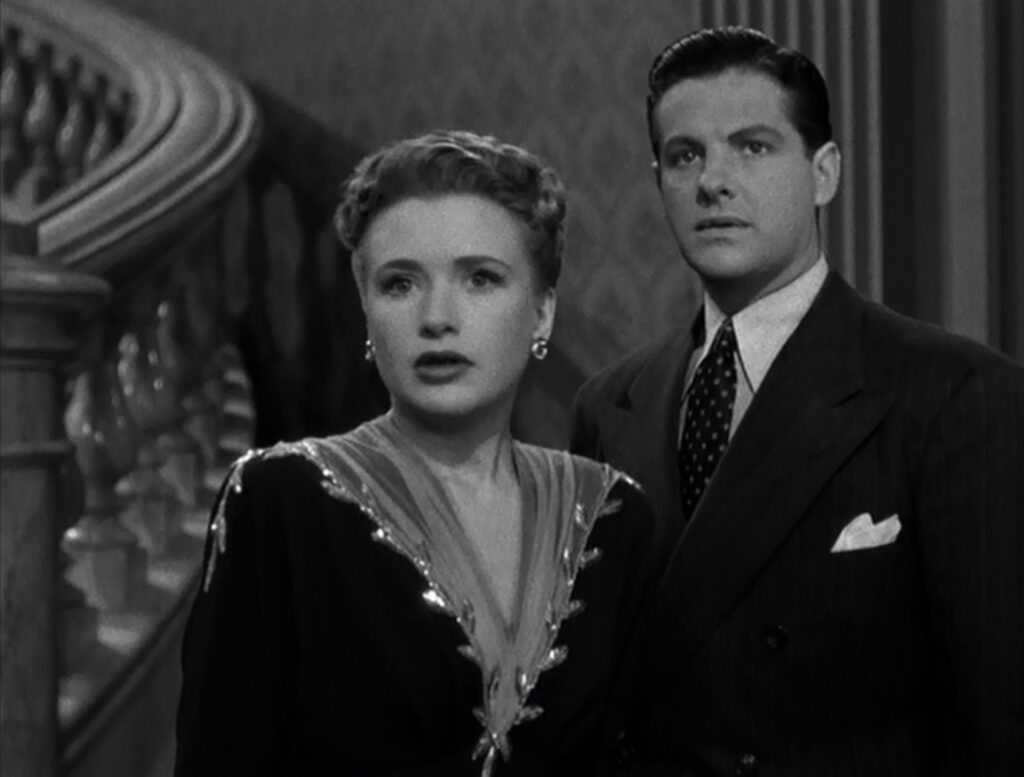
Saboteur pairs nicely with Shadow of a Doubt, made a few months later, which also locates the apex of idealized American life in California, at the western edge of the country. Seventeen years later Hitchcock’s view of the United States would sour so much that in North by Northwest he reverses the direction of Saboteur, traveling from New York to a nest of corruption in the west, climaxing at Mount Rushmore instead of the Statue of Liberty.
As warmly as Hitchcock felt toward the United States at the time, Saboteur is not mere jingoism. The director’s love for his adopted country was rooted in its egalitarian ideals. In America there was no shame in being ordinary, and Hitchcock’s movies always give importance to common people – not only entrusting them with the fate of the world, but holding them responsible for society’s failures. While most people tend to lay blame or credit on the elite or powerful, Hitchcock felt that the world was shaped by people in small roles who either yielded or denied power to the elites over them. The idea goes back to Hitchcock’s Sabotage (1936) in which the Scotland Yard superintendent, referring to international criminal masterminds, tells his detective, “They’re the ones that you and I will never catch. It’s the men they employ that we’re after.” Hitchcock’s films are more concerned with the smaller villains, the stooges and minions who help the masterminds like Tobin, and they’re likewise interested in ordinary people like Barry Kane who save the world by acting out of necessity.
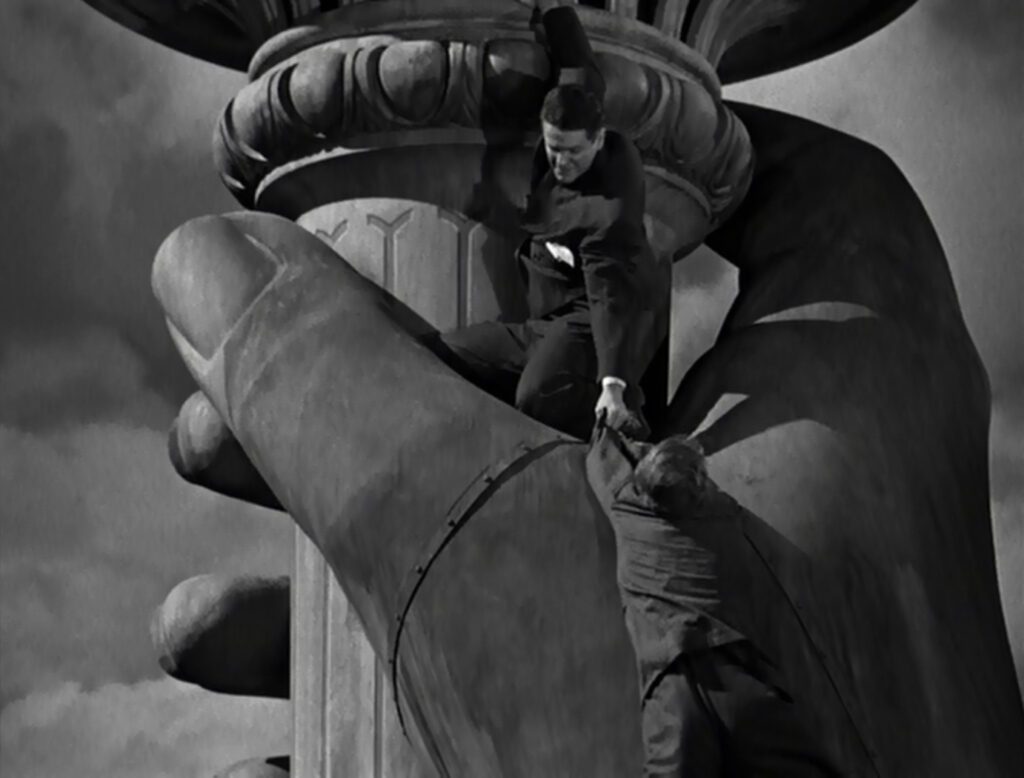
Frank Fry is typical of Hitchcock’s low-level villains, and his name evokes the phrase “small fry” that describes so exactly whom Hitchcock holds responsible for the world’s problems. Charles Tobin would have no power without characters like Fry willing to do his dirty work, and Tobin accordingly disappears from the story, never to be heard from again. On the other side, characters like the truck driver, Philip Martin, the circus performers, Patricia Martin, and Barry Kane are simple, honest, ordinary people thrust by accident into roles of great consequence. This is exactly what Mr. Martin stresses when he tells Kane to “get back in practice on that triangle.” The triangle is the smallest and most humble instrument in the orchestra, but it’s still an essential part of a symphony. This thinking would have resonated with millions of soldiers, factory workers, and other ordinary people, the Barry Kanes of the world, playing needed roles in a great wartime cause.
CONNECTIONS:
The 39 Steps – Frozen image of Mr. Memory / impassive face of the Statue of Liberty
Sabotage – Contrast between “small fry” and the masterminds they assist
Citizen Kane – Character named “Kane” with real/implied label of “citizen”
Shadow of a Doubt – Ode to ordinary American life; California stands for the virtue of the West, with tyranny/crime spreading from the East
Born Yesterday – Celebration of American culture with visits to famous landmarks; contrast between American ideals and corrupted European culture
North by Northwest – Journey across the U.S. reflecting Hitchcock’s feelings about the country (west to east, east to west); famous sculpted landmark at climax (Liberty/Rushmore)
Frenzy – Black smoke crosses the screen near the beginning to signify corruption
The Shining – Pattern of Americana throughout the movie